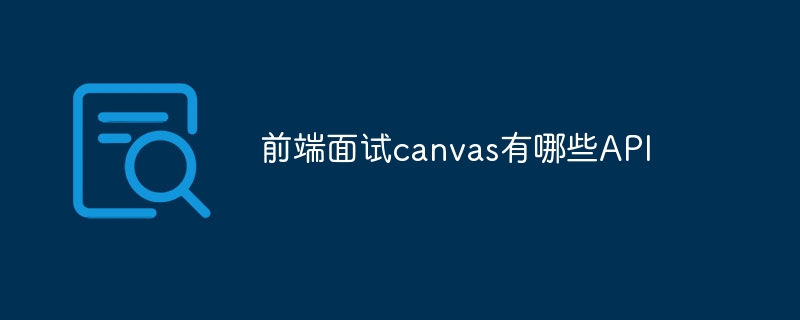
The front-end interview canvas has "element-related API", "drawing graphics and path-related API", "drawing text-related API" and "image-related API": 1. Element-related API, getContext('2d') , get the 2D drawing context; 2. Draw graphics and path related API, fillStyle: set the fill color or style; 3. Draw text related API, font, set the font style of drawing text; 4. Image related API, drawImage() draws the image .

# Operating system for this tutorial: Windows 10 system, Dell G3 computer.
In front-end interviews, some common APIs about Canvas include:
Canvas element related API:
Drawing graphics and path related API:
Drawing text related API:
Image related API:
The following is an example that demonstrates how to draw a simple graphic using the Canvas API:
<!DOCTYPE html>
<html>
<head>
<title>Canvas API示例</title>
<style>
/* 这里可以定义样式 */
</style>
<script>
window.onload = function() {
const canvas = document.getElementById('myCanvas');
const ctx = canvas.getContext('2d');
// 设置绘制属性
ctx.fillStyle = 'red'; // 设置填充颜色为红色
ctx.strokeStyle = 'blue'; // 设置描边颜色为蓝色
// 绘制矩形
ctx.fillRect(50, 50, 200, 100); // 绘制填充矩形
ctx.strokeRect(50, 50, 200, 100); // 绘制描边矩形
// 绘制圆形
ctx.beginPath();
ctx.arc(300, 200, 50, 0, Math.PI * 2); // 绘制一个圆形路径
ctx.closePath();
ctx.fill(); // 填充圆形
ctx.stroke(); // 描边圆形
// 绘制文本
ctx.font = '24px Arial'; // 设置字体样式和大小
ctx.fillText('Hello, Canvas!', 100, 300); // 填充文本
ctx.strokeText('Hello, Canvas!', 200, 350); // 描边文本
}
</script>
</head>
<body>
<h1>Canvas API示例</h1>
<canvas id="myCanvas" width="500" height="400"></canvas>
<!-- 其他HTML内容... -->
</body>
</html>In the above example, we create a Canvas element, And obtained the 2D drawing context. We then use the Canvas API to set drawing properties such as fill color and stroke color, and use related methods to draw rectangles, circles, and text. You can try modifying parameter values and using other APIs and properties to draw different graphics and effects.
The above is the detailed content of What are the APIs for front-end interview canvas?. For more information, please follow other related articles on the PHP Chinese website!
 What are the production methods of html5 animation production?
What are the production methods of html5 animation production?
 html file opens blank
html file opens blank
 Top 10 currency exchanges
Top 10 currency exchanges
 How to use ucsc database
How to use ucsc database
 How to set header and footer in Word
How to set header and footer in Word
 What are the linux deletion commands?
What are the linux deletion commands?
 Main contents of database conceptual design
Main contents of database conceptual design
 Solution to WIN10 update failure
Solution to WIN10 update failure
 What does ps mask mean?
What does ps mask mean?




